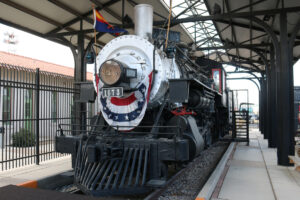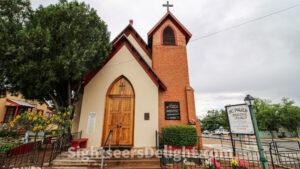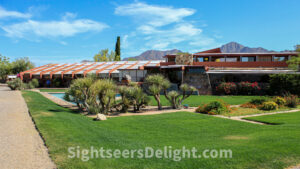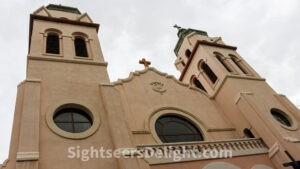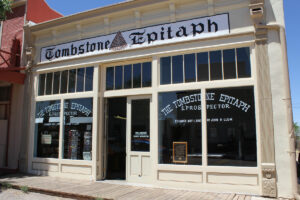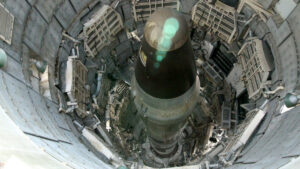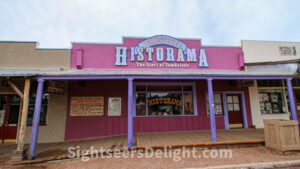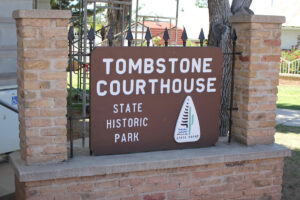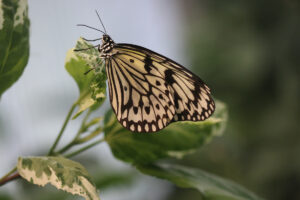The Southern Arizona Transportation Museum preserves and interprets the history of railroads in southern Arizona. The one-time records vault building at the former Southern Pacific depot houses the museum. The city of Tucson purchased the building in 1998 and renovated it in 2004 to restore it to its 1941 style. Tucson Mayor Bob Walkup helped dedicate the museum on March 20, 2005, the 125th anniversary of the arrival of the railroad in Tucson. The centerpiece of this museum is Southern Pacific locomotive No. 1673. Schenectady Locomotive Works built the steamer in 1900, and it starred in the movie Oklahoma in 1955.
85701
While many of the historical sites around Tombstone are not original to the days when Wyatt Earp and Doc Holliday wandered the dusty streets of Tombstone, nearly every aspect of St. Paul’s Episcopal Church dates to 1882 when the church opened. Rev. Talbot and the Arizona-New Mexico Episcopal Diocese began construction of the church, and Endicott Peabody completed it in June 1882. The church, located at Safford and Third streets, cost $5,000. While many businesses in town closed over the years, St. Paul’s Episcopal Church did not, surviving the town’s leaner times. It continues to hold weekly services.
85638
On March 20, 1882, Deputy U.S. Marshal Wyatt Earp shot and killed Frank Stillwell in the Tucson train yards. Stillwell likely killed Earp’s brother, Morgan, following the Shootout at the OK Corral in Tombstone, and Earp formed a posse to hunt down to pursue suspects, an event later remembered as the Earp Vendetta Ride. Sculptor Dan Bates created the statue of Earp and Doc Holliday that stands near the historic Tucson depot. The sculpture debuted on March 20, 2005, the anniversary of the shooting, as part of an overhaul of the historic train depot. Following the shooting of Stillwell, Earp fled Arizona as he was wanted for murder.
85701
By the 1930s, when Frank Lloyd Wright and the Taliesin Fellowship began trekking west for the winter, Wright was an established architect. Taliesin West served as the winter home and school for Wright from 1937 until his death in 1959 at the age of 91. The complex drew its name from Taliesin, in Spring Green, Wisc., which served as a summer home for Wright.
85259
The Church of the Immaculate Conception of the Blessed Virgin Mary, also called St. Mary’s Basilica, is the oldest Catholic parish and the second oldest church in Phoenix. Between 1872 and 1881, Catholic priests from Florence, Arizona, would travel by buggy every three months to perform the liturgy. The building was constructed between 1902 and 1914, blending the Mission Revival and Spanish Colonial Revival architectural styles. It was officially dedicated in 1915 and replaced an earlier adobe church built in 1881 when the parish was founded. Starting in 1895, Franciscan Friars staffed the parish. Until 1924, it was the only Catholic parish in Phoenix. On September 6, 1976, the Arizona Historical Society named St. Mary’s an historic site. About a decade later, in 1985, Pope John Paul II elevated the church to a minor basilica.
85004
The Tombstone Epitaph is perhaps the most revered institution in Tombstone, Arizona. John P. Clum founded the newspaper in 1880, and today, it is the oldest continuously published newspaper in the Grand Canyon State. Since the town was name Tombstone and “every Tombstone needs an epitaph,” as Clum would later say, the newspaper had its name. The publication witnessed history, when, in 1881, it reported on the now-infamous Shootout at the OK Corral. Today, the paper is a monthly journal of western history. Students at the University of Arizona continue to publish a local edition of The Tombstone Epitaph. The newspaper office in Tombstone is a museum about its role in the community.
85638
During the 1960s, the U.S. Air Force built 54 missile silos around the country, including 18 around Tucson, Ariz., to defend the country in case of attack. By the 1980s, these Titan Missile silos were obsolete, so President Reagan decommissioned them. The Titan Missile Museum opened on May 21, 1986, inside the former Titan II Missile Site 8 (571-7) in Sahuarita, Ariz., about 20 miles south of Tucson. The museum interprets life at the complex and the steps to fire the missile. The centerpiece of the museum is an inert Titan II intercontinental ballistic missile in the silo.
85614
Tombstone’s Historama offers a historically accurate multimedia account of the history of Tombstone. It features the town’s story from the days of Geronimo’s Apaches to the more recent times and, of course, includes information about the Gunfight at the O.K. Corral. The 25-minute show, narrated by actor Vincent Price, also highlights the fires that devastated the community and the flooding that ultimately spelled the end for Tombstone’s mines, making it a helpful overview for anyone looking for more about the backstory of the “Town Too Tough to Die.” Admission to Tombstone’s Historama in included with a ticket to the O.K. Corral.
85638
There are two versions of Tombstone. The first is the stuff of legends. The second is the real history, which while entertaining and almost unbelievable, is a little less grandiose. For anyone especially interested in learning the full story of Tombstone, a visit to the Tombstone Courthouse is an absolute must. Cochise County built the courthouse in 1882 for administrators of the then-newly created Cochise County. It remained in use until 1929, when the county seat relocated to Bisbee. After its abandonment, proprietors planned to repurpose the courthouse as a hotel, but today the courthouse houses a museum dedicated to telling the historically accurate story of Tombstone.
85638
Horticulturist and collector Harrison G. Yocum started the Tucson Botanical Gardens in his home in 1964. After moving to Randolph Park, the gardens moved to their current location, at the historic Porter Family property, in 1974. The five-and-a-half-acre Tucson Botanical Gardens is home to a range of plants native to the local region, including cacti and arid plants. Its Butterfly & Orchid Pavilion, open from October to May, features a display of live tropical butterflies from five continents. The garden also showcases orchids, bromeliads and jungle vegetation.
85712

